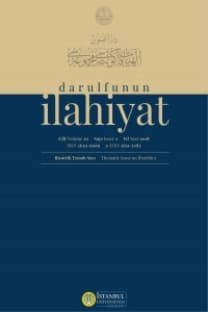OSMANLI DÖNEMİ FENER RUM PATRİKLERİNİN SEÇİMİ
Fener Patrikleri, Ortodoks, Seçimler, Sultan /İmparator, Kutsal Sinod
The Elections of The Phanar Patriachs in The Ottoman Period
Phanar Patriarchs, Orthodox, Elections, Sultan / Emperor, The Holy Synod,
___
- G.W.H.Lampe (ed). A Patristic Greek Lexicon, Oxford University Press, 1972
- Akyıldız, Ali. “Tanzimat” DİA, 40/1-‐‑10.
- Arrnakis, G. Georgiades. “The Greek Church of Constantinople and The Ottoman Empire”, The Journal of Modern History, Vol 24, No 3 (Sep. 1952), ss. 235-‐‑250.
- Atalay, Bülent. Fener Rum Ortodoks Patrikhane’sinin Siyasi Faaliyetleri (1908-‐‑1923), Tarih ve Tabiat Vakfı Yay., İstanbul, 2001.
- Başbakanlık Osmanlı Arşiv Rehberi, (Komisyon), İstanbul 2010.
- Decei, Aurel. “Patrik II. Gennadios Skolarios’un Fatih Sultan Mehmet İçin Yazdığı Ortodoks İ’tikad-‐‑Namesinin Türkçe Metni”, Fatih ve İstanbul, Cilt 1, Sayı 1, İstanbul 1953, s.99-‐‑116. Düstur, I. Tertip, C.II, 1289.
- Emperors Patriarchs and Sultans of Constantinople 1373-‐‑1513, An Anany-‐‑ mous Greek Chronicle of The Sixteenth Centry (Trans. And Commentary by Marios Philippides) Hellenic College Press, Brookline 1990.
- Hussey, J. M., The Orthodox Church in the Byzantine Empire, Oxford Uni-‐‑ versity Pres, 1990.
- İmerologion tu İkumeniku Patriarhiu Etus 2009, (2009 Yılı Patrikhane Yıllığı), Ekdosis İkumeniku Patriarhiu, Selanik, 2009.
- İnalcık,Halil. “TheStatus of the Greek Orthodox Patriarch Under the Ot-‐‑ tomans”,Turcica, 23/1991, ss.407-‐‑435.
- İnci, Salih. “Balkanlarda Mezhep Kavgaları ve Kiliselerin Nüfuz Müca-‐‑ delesi”, Yeni Türkiye Rumeli-‐‑Balkanlar Özel Sayısı-‐‑III, Yıl 21, Sayı 68, Ankara 2015. ss.3040-‐‑3051.
- Jorga, Nicolae. Osmanlı İmparatorluğu Tarihi, (1-‐‑5) (Çev. Nilüfer Epçeli), İstanbul, 2005.
- Karaca, Filiz. “Pişkeş”, DİA, 34/294-‐‑296.
- Karpat, Kemal. Balkanlar’da Osmanlı Mirası ve Ulusçuluk,(çev.Recep Bozte-‐‑ mur), İmge Kitabevi, İst. 2004
- ……….“Ottoman Views and Policies Towards The Orthodox Christian Church”, Greek Orthodox Theological Review, Volume 31, No. 1-‐‑2, Brookline 1986, ss.131-‐‑155. Kenanoğlu, M. Macit. Osmanlı Millet Sistemi Mit ve Gerçek, Klasik Yay., İs-‐‑ tanbul, 2004.
- Kofos, Evangelos. “Attempts at Mending the Greek – Bulgarian Ecclesi-‐‑ astical Schism (1875-‐‑1902)”, Balkan Studies, Volume 25, Number 2, Selanik, 1984, ss. 347-‐‑368.
- Konortas, Paraskevas “Osmanlı İmparatorluğunda En Üst Düzey Ruh-‐‑ ban Sınıfının ve Özellikle Patriğin Konumu Üzerine Bazı Hipotezler (1453-‐‑ 1923)”, Ortodoksia (II. Period) Yıl 7, sayı 3, Selanik 2000 (Temmuz-‐‑Eylül), ss. 461-‐‑ 480. …………“Tarihi Uzlaşmadan Entente Cordial’e”, Tarihi Siyasi Dini ve Hukuki Açıdan Ekümenik Patrikhane, (Der. Cengiz Aktar), İletişim Yayınları, İs-‐‑ tanbul 2011, ss.27-‐‑68.
- Macar, Elçin, Cumhuriyet Döneminde İstanbul Rum Patrikhanesi, İletişim Yayınları, İst.,2003.
- Ortaylı, İlber. Osmanlıda Milletler ve Diplomasi, Seçme Eserler, İst. Türkiye İş Bank. Yay, 2008. s. 22
- Ostrogorsky, George. Bizans Devleti Tarihi.(Çev. Fikret Işıltan), Türk Ta-‐‑ rih Kurumu, Ankara, 1999 (Beşinci baskı)
- Pertusi, Agostino. İstanbul’un Fethi I, Çağdaşların Tanığı (çeviren ve notlar ekleyen Mahmut H. Şakiroğlu),İstanbul Fetih Cemiyeti, 2004.
- Runciman, Steven. The Great Church in Captivity, New York : Camridge University Press, 1968.
- ………….The Byzantine Theocracy, : London -‐‑ New York – Melbourne, Camridge University Press, 1977.
- Seidler, G.L. Bizans Siyasal Düşüncesi (çev. Mete Tunçay), Ankara Üniver-‐‑ sitesi Siyasal Bilgiler Fakültesi Yayınları, Ankara, 1980.
- Stavridis, Vasilios. İstoria tu İkumeniku Patriarhiu 1453-‐‑Simeron, Ekdotikos İkos Adelfon Kiriakidi, Selanik, 1987.
- ………….“A Concise History of The Ecumanical Patriarchate”, (Trans. From the Greek George Dion. Dragas), Greek Orthodox Theological Review, 45 /1-‐‑4, 2000, ss. 57-‐‑140
- Stavrionis, L. S. The Balkans Since 1453, Rinehart&Company, New York : 1958.
- Uzunçarşılı, İsmail Hakkı. Osmanlı Tarihi, Cilt II, 7.basım, s. 157-‐‑159
- http://www.patriarchate.org/patriarchate/former-‐‑patriarchs/jeremias (erişim13.05.2014)
- http://www.ec-‐‑patr.org/list (erişim tarihi 19.05.2014)
- http://en.wikipedia.org/wiki/Patriarch_Gabriel_II_of_Constantinople (erişim tarihi 19.05.2014)
- http://en.wikipedia.org/wiki/Patriarch_Parthenius_III_of_Constantinople (erişim. 19.05.2014)
- Yayın Aralığı: Yılda 2 Sayı
- Başlangıç: 1925
- Yayıncı: İstanbul Üniversitesi İlahiyat Fakültesi
Osmanlı Kitap Kültürü: Cârullah Efendi Sempozyumu (İlmi Etüdler Derneği, 15 Şubat 2015)
Doğrudan Satış Yöntemlerinden Çok Katlı Pazarlama (Network Marketing) ve Fıkhî Değerlendirmesi
Kadınların Cemaatle Kılınan Namazlara İştiraki ve Namazlarının Edası
Adli Psikiyatrinin Verileri Işığında Dini Sorumluluklara Psikolojik Bakış
OSMANLI DÖNEMİ FENER RUM PATRİKLERİNİN SEÇİMİ
Isaac Mayer Wise: Amerikan Reform Yahudiliğinin Kurucusu
el-‐‑Menar Tefsiri’nin Siyasi Boyutu (Bir Grup Siyasi Konunun Tartışılması ve Analiz Edilmesi)
“Şîa ve Hadis” Paneli, (Bilim ve Sanat Vakfı Medeniyet Araştırmaları Merkezi, 18 Nisan 2015)
Meşrutiyet’ten Cumhuriyet’e Yakın Tarihimizin Belgesi 1908-1925 Sırâtımüstakīm Mecmuası
“Şîa ve Hadis” Paneli, (Bilim ve Sanat Vakfı Medeniyet Araştırmaları Merkezi
